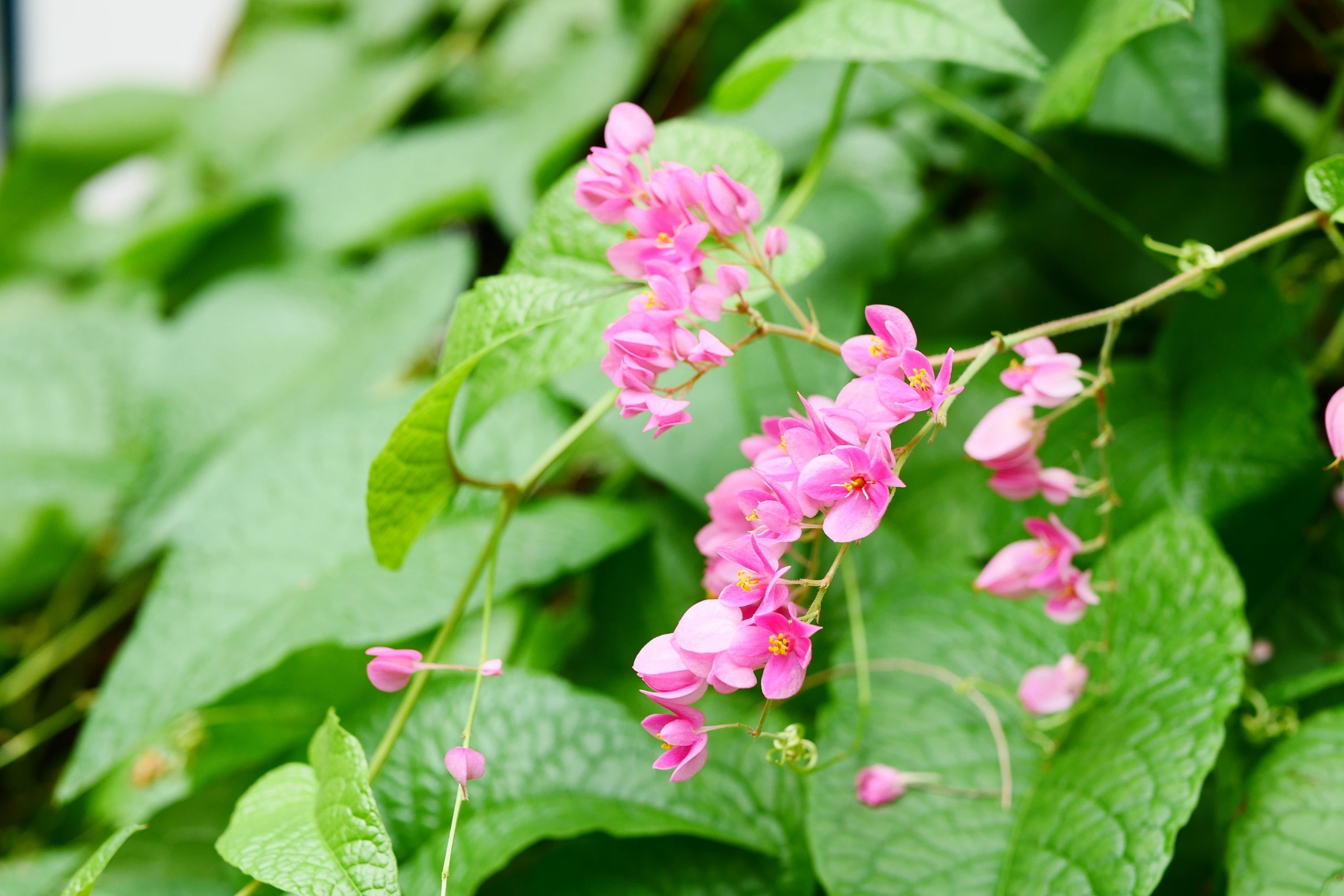Coral vine
(Antigonon leptopus)

Description
Antigonon leptopus, commonly known as the Coral Vine or Mexican Creeper, is a flowering plant that belongs to the Polygonaceae family. Native to Mexico, this captivating vine has gained popularity worldwide due to its vibrant pink flowers and vigorous growth habit. In this article, we will delve into the various aspects of Antigonon leptopus, including its botanical features, cultivation requirements, ecological significance, and its cultural and historical significance. Botanical Features Antigonon leptopus is a deciduous climbing vine that can reach impressive heights of up to 40 feet (12 meters). Its twining stems are slender and flexible, allowing the plant to gracefully entwine itself around supporting structures such as fences, trellises, or trees. The leaves of Antigonon leptopus are heart-shaped, typically measuring around 1 to 2 inches (2.5 to 5 cm) in length. They are arranged alternately along the stems and possess a glossy green surface. One of the most striking features of Antigonon leptopus is its vibrant flowers. The plant produces numerous pendulous clusters of small, tubular flowers, which are a vivid shade of pink. These flower clusters can measure up to 6 inches (15 cm) in length, creating a stunning display of color. The individual flowers of Antigonon leptopus are about 0.5 to 0.75 inches (1.3 to 2 cm) in diameter and possess five petals fused at the base, forming a distinct trumpet-like shape. The blooming period of the Coral Vine typically occurs during the summer months, although it may vary depending on the local climate. Habitat and Range Antigonon leptopus, commonly known as the Coral Vine or Mexican Creeper, is native to the tropical regions of Mexico. Its natural habitat primarily includes parts of central and southern Mexico, where it thrives in a variety of environments. The vine is well-adapted to warm and subtropical climates, making it suitable for regions with long, hot summers and mild winters. Outside its native range, Antigonon leptopus has been introduced and naturalized in various other regions around the world. It is cultivated and grown as an ornamental plant in tropical and subtropical areas, where it can escape cultivation and establish itself in the wild. It has been reported as naturalized in several countries, including parts of the United States, such as Florida and Texas, as well as in parts of Central America, the Caribbean, and certain Pacific islands. Due to its invasive potential and ability to spread rapidly, caution should be exercised when cultivating Antigonon leptopus outside its native range. It is important to prevent its escape into natural areas where it can displace native plant species and impact local ecosystems. Cultivation Requirements Antigonon leptopus is a resilient and adaptable plant, making it suitable for a wide range of growing conditions. It thrives in full sun exposure and prefers well-draining soil. Although it can tolerate a variety of soil types, including sandy or clay soils, providing a fertile and loamy substrate will promote optimal growth and flowering. Regular watering is essential during the establishment period, but once established, Antigonon leptopus can tolerate moderate drought conditions. Pruning and training are necessary to maintain the desired shape and size of the plant. Trimming back the vine in late winter or early spring helps control its growth and prevents it from becoming invasive. It is important to note that Antigonon leptopus has a vigorous growth habit and may require regular monitoring to prevent it from overwhelming other plants or structures in the garden. Ecological Significance Antigonon leptopus not only adds aesthetic value to gardens and landscapes but also provides ecological benefits. The vibrant flowers of the Coral Vine attract a wide array of pollinators, including bees, butterflies, and hummingbirds, which play a crucial role in pollination and the overall health of ecosystems. Furthermore, Antigonon leptopus can serve as a valuable habitat and food source for beneficial insects and other small wildlife. Invasive Potential While Antigonon leptopus is cherished for its ornamental value and beneficial qualities, it is essential to consider its potential invasiveness in certain regions. The Coral Vine has shown invasive tendencies in some areas where it has been introduced, such as parts of Florida and Hawaii. Its ability to self-seed and spread rapidly can result in the displacement of native plant species. Therefore, it is important to exercise caution when cultivating Antigonon leptopus in regions where it is not native and to prevent its escape into natural areas. Cultural and Historical Significance Antigonon leptopus has cultural and historical significance in its native Mexico. In Mexican folklore, the plant is associated with love and romance. It is often referred to as "cadena de amor," which translates to "chain of love," highlighting its symbolic connection to affection and emotional bonds. The Coral Vine's beautiful pink flowers have been used in traditional celebrations, including weddings and other festive occasions, where they are incorporated into decorations and floral arrangements. Additionally, Antigonon leptopus holds a place in Mexican herbal medicine. Various parts of the plant, including the leaves and flowers, have been used in traditional remedies for their potential therapeutic properties. It is believed that extracts from the vine possess anti-inflammatory and diuretic properties and have been used to treat conditions such as arthritis and urinary tract infections. However, it is important to note that scientific research on the medicinal properties of Antigonon leptopus is limited, and caution should be exercised when using it for therapeutic purposes. Importance in Horticulture Antigonon leptopus has captivated gardeners and plant enthusiasts around the world due to its enchanting flowers and vigorous growth habit. It is often cultivated as an ornamental vine in tropical and subtropical regions, where it adds a touch of vibrant color to landscapes, gardens, and arbors. The Coral Vine's ability to cover unsightly structures, provide shade, and attract pollinators makes it a popular choice for vertical gardening and creating natural screens. Furthermore, the ease of propagation through seeds or stem cuttings makes Antigonon leptopus accessible to gardeners of various skill levels. Its fast growth rate and adaptability make it suitable for covering fences, trellises, and pergolas, transforming them into living tapestries of pink blooms. However, it is crucial to monitor and manage its growth to prevent its spread into natural areas and the displacement of native flora. Conclusion Antigonon leptopus, the Coral Vine or Mexican Creeper, is a captivating climbing vine known for its vibrant pink flowers and vigorous growth. With its attractive foliage, stunning floral display, and ecological benefits, it has become a popular choice for ornamental gardening in many regions. However, caution must be exercised to prevent its escape into natural areas where it can become invasive and outcompete native plant species. Appreciating the beauty and cultural significance of Antigonon leptopus, while being mindful of its potential impact on local ecosystems, allows us to enjoy this remarkable plant responsibly. Whether adorning garden structures, attracting pollinators, or carrying cultural and historical symbolism, the Coral Vine continues to enchant and inspire individuals with its natural splendor.
Taxonomic tree:







